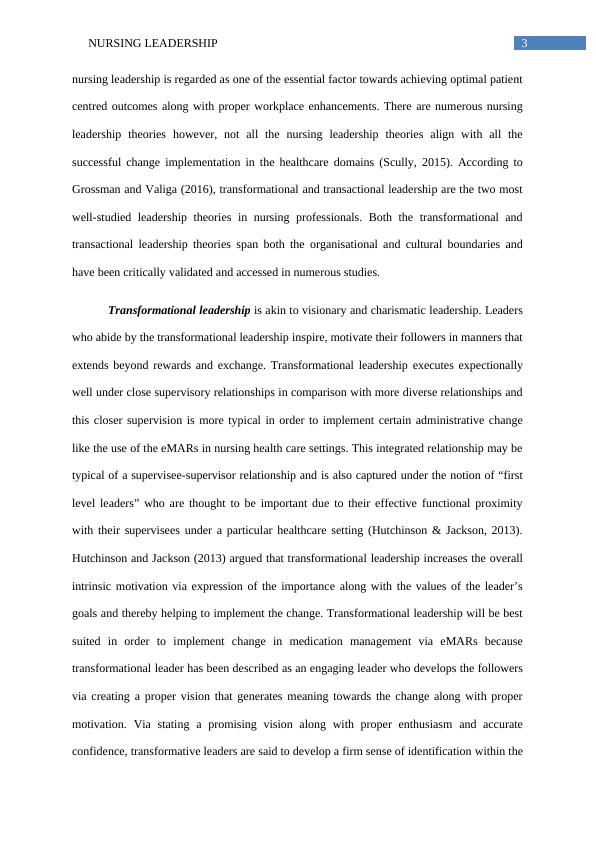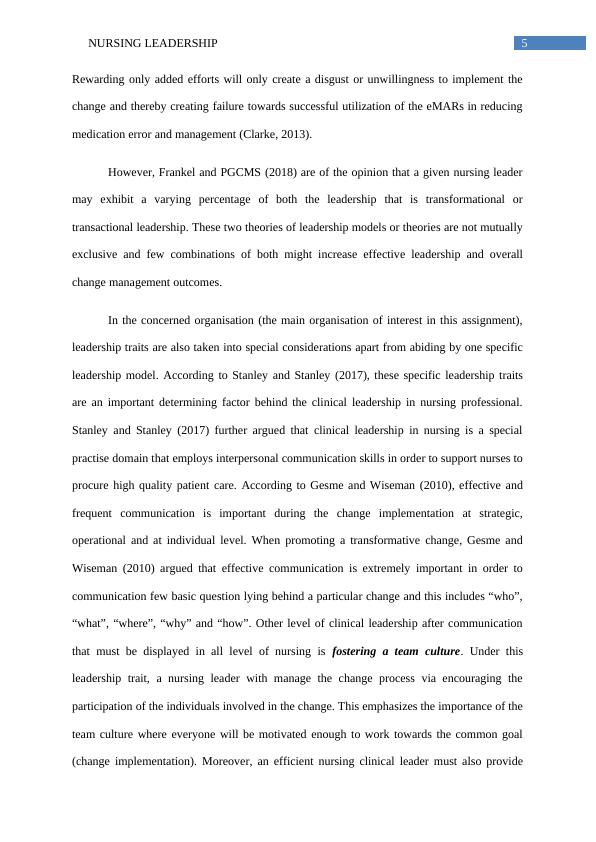(Doc) A Review on Leadership in Nursing
22 Pages5484 Words46 Views
Added on 2021-05-31
(Doc) A Review on Leadership in Nursing
Added on 2021-05-31
ShareRelated Documents
0Running head: NURSING LEADERSHIPNursing LeadershipName of the StudentName of the UniversityAuthor Note

1NURSING LEADERSHIPTable of ContentsIntroduction................................................................................................................................2Discussion..................................................................................................................................2Leadership..............................................................................................................................2Innovation in healthcare.........................................................................................................6Change and change management...........................................................................................8Use of evidence to support the change.................................................................................13Conclusion................................................................................................................................14References................................................................................................................................16Appendix..................................................................................................................................20SMART Goals......................................................................................................................20

2NURSING LEADERSHIPIntroductionAccording to Ashcroft et al (2015), medicines or drugs are the most commonlyemployed clinical interventions under the healthcare settings. However, the use of drugstowards the successful treatment of the patients is at times associated with sudden degree oferror. Berdot et al. (2012) argued that medication error can occur during, dispensing,prescribing and administration of drug. The results of this medication error are fatal whichmay lead to the development of chest aspiration, pneumonia or worse intracarnialhaemorrhage. In relation of medication management, Berdot et al. (2012) is of the opinionthat the drug error is the single most avoidable cause behind the subsequent patient’s harm. Inorder to reduce the medication cost subsequent harm to patients electronic medicationadministration records are gradually gaining importance (eMARs). According to GuoIribarren, Kapsandoy, Perri and Staggers (2011), eMARs can be used to support medicationmanagement in order to decrease the rate of medication errors, while promoting patient safetyalong with the improvement of the overall workflow efficiency. DiscussionLeadershipAccording to Scully (2015), nursing is challenging yet dynamic profession whichdemands engaging and inspiring leaders and role models. In present day ever changing yetextremely demand healthcare environment, proper identification along with development ofappropriate nursing leadership is one of the biggest challenges experienced by the individualsin the nursing profession. The overall concept of the nursing leadership is complex and hasmulti-dimensional approach. Hutchinson and Jackson (2013) is of the opinion that effective

3NURSING LEADERSHIPnursing leadership is regarded as one of the essential factor towards achieving optimal patientcentred outcomes along with proper workplace enhancements. There are numerous nursingleadership theories however, not all the nursing leadership theories align with all thesuccessful change implementation in the healthcare domains (Scully, 2015). According toGrossman and Valiga (2016), transformational and transactional leadership are the two mostwell-studied leadership theories in nursing professionals. Both the transformational andtransactional leadership theories span both the organisational and cultural boundaries andhave been critically validated and accessed in numerous studies. Transformational leadership is akin to visionary and charismatic leadership. Leaderswho abide by the transformational leadership inspire, motivate their followers in manners thatextends beyond rewards and exchange. Transformational leadership executes expectionallywell under close supervisory relationships in comparison with more diverse relationships andthis closer supervision is more typical in order to implement certain administrative changelike the use of the eMARs in nursing health care settings. This integrated relationship may betypical of a supervisee-supervisor relationship and is also captured under the notion of “firstlevel leaders” who are thought to be important due to their effective functional proximitywith their supervisees under a particular healthcare setting (Hutchinson & Jackson, 2013).Hutchinson and Jackson (2013) argued that transformational leadership increases the overallintrinsic motivation via expression of the importance along with the values of the leader’sgoals and thereby helping to implement the change. Transformational leadership will be bestsuited in order to implement change in medication management via eMARs becausetransformational leader has been described as an engaging leader who develops the followersvia creating a proper vision that generates meaning towards the change along with propermotivation. Via stating a promising vision along with proper enthusiasm and accurateconfidence, transformative leaders are said to develop a firm sense of identification within the

4NURSING LEADERSHIPorganisation thereby persuading individuals to transcend their own self-interest. However,transformational leadership model has certain form of limitation like dichromaticinterpretation of the leadership while keeping the focus upon the heroic or charismatic leadersand providing minimal insight into the leader integrity (Hutchinson & Jackson, 2013).Nevertheless, these limitations can be overcomed via the human-capital-enhancing resourcemanagement style of transformational leaders. This particular style will motivate themembers of the team beyond their own expectations and thereby helping them to inherit andsuccessfully implement the change in the medication management under nursing care(Hutchinson & Jackson, 2013).In contrast to the transformational leadership, transactional leadership model isbased on “exchanges” between the follower and leader under which the follower is rewardedfor satisfying specific performance criteria or goals. Though transactional leadership is morepractical in nature as it give importance towards meeting specific targets or objectives, it hascertain level of limitations (Dumdum, Lowe & Avolio, 2013). Dumdum, Lowe and Avolio(2013) is of the opinion that transactional leaders are said to achieve performance whenrequired via contingent rewards or via negative feedbacks. The focus of the transactionalleaders is to focus mainly upon the structures while clarifying the tasks along with providingvalid rewards only for extra efforts or satisfying the requirement of the team members onlywhen they meet or comply the expectations. This specific pattern of achieving performanceof the followers via contingent reward has been conceptualized as much lower orderleadership function. Thus the transactional leadership model might not be suitable for theimplementation of fresh new change in the nursing practise. Clarke (2013) is of the opinionthat while implementing any advanced technological change in the nursing practise like in thecase of eMARs, it is the duty of a nursing leader to acknowledge each and every initiativetaken by a nursing professional towards effective medication management through eMARs.

5NURSING LEADERSHIPRewarding only added efforts will only create a disgust or unwillingness to implement thechange and thereby creating failure towards successful utilization of the eMARs in reducingmedication error and management (Clarke, 2013). However, Frankel and PGCMS (2018) are of the opinion that a given nursing leadermay exhibit a varying percentage of both the leadership that is transformational ortransactional leadership. These two theories of leadership models or theories are not mutuallyexclusive and few combinations of both might increase effective leadership and overallchange management outcomes.In the concerned organisation (the main organisation of interest in this assignment),leadership traits are also taken into special considerations apart from abiding by one specificleadership model. According to Stanley and Stanley (2017), these specific leadership traitsare an important determining factor behind the clinical leadership in nursing professional.Stanley and Stanley (2017) further argued that clinical leadership in nursing is a specialpractise domain that employs interpersonal communication skills in order to support nurses toprocure high quality patient care. According to Gesme and Wiseman (2010), effective andfrequent communication is important during the change implementation at strategic,operational and at individual level. When promoting a transformative change, Gesme andWiseman (2010) argued that effective communication is extremely important in order tocommunication few basic question lying behind a particular change and this includes “who”,“what”, “where”, “why” and “how”. Other level of clinical leadership after communicationthat must be displayed in all level of nursing is fostering a team culture. Under thisleadership trait, a nursing leader with manage the change process via encouraging theparticipation of the individuals involved in the change. This emphasizes the importance of theteam culture where everyone will be motivated enough to work towards the common goal(change implementation). Moreover, an efficient nursing clinical leader must also provide

End of preview
Want to access all the pages? Upload your documents or become a member.
Related Documents
Nursing Leadershiplg...
|11
|3174
|308
Importance of Nursing Leadership in Improving Patient Carelg...
|9
|2606
|69
Position Paper: Medication Errorlg...
|15
|3895
|182
Medication Error by Nurses: Systematic Reviewlg...
|13
|2827
|433
Critical Appraisal of an Article on Medication Safety Practiceslg...
|7
|1916
|484
Effective Nursing Leadership Styles for Quality Patient Outcomelg...
|7
|1536
|129
